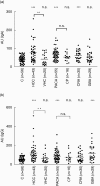Calreticulin is a B cell molecular target in some gastrointestinal malignancies
- PMID: 20030668
- PMCID: PMC2857944
- DOI: 10.1111/j.1365-2249.2009.04085.x
Calreticulin is a B cell molecular target in some gastrointestinal malignancies
Abstract
Calreticulin, upon translocation to the cell surface, plays a critical role in the recognition of tumour cells and in experimentally induced cellular anti-tumour immunity. However, less is known about anti-calreticulin antibodies and their role in malignancies. Using enzyme-linked immunosorbent assay (ELISA), we found immunoglobulin (Ig)A and/or IgG anti-calreticulin antibodies in sera of approximately 63% of patients with hepatocellular carcinoma (HCC), 57% of patients with colorectal adenocarcinoma (CRA) and 47% of patients with pancreatic adenocarcinoma (PACA), while healthy controls, patients with viral hepatitis C and with chronic pancreatitis reached only 2%, 20% and 31% seropositivity, respectively. We found significantly elevated mean levels of IgA anti-calreticulin antibodies (P < 0.001) in patients with HCC (78.7 +/- 52.3 AU, mean +/- standard deviation), PACA (66.5 +/- 30.9 AU) and CRA (61.8 +/- 25.8 AU) when compared to healthy controls (41.4 +/- 19.2 AU). Significantly elevated mean levels of IgG anti-calreticulin antibodies (P < 0.001) were detected in patients with HCC (121.9 +/- 94.2 AU), gall bladder adenocarcinoma (118.4 +/- 80.0 AU) and PACA (88.7 +/- 55.6 AU) when compared to healthy controls (56.7 +/- 22.9 AU). Pepscan analysis revealed a large number of antigenic epitopes of calreticulin recognized by both IgA and IgG antibodies of patients with HCC and PACA, indicating robust systemic immune response. Moreover, significantly elevated levels of antibodies against peptide KGEWKPRQIDNP (P < 0.001) in these patients, tested by ELISA, confirmed the distinct character of antibody reactivity against calreticulin. The high occurrence and specificity of serum anti-calreticulin autoantibodies in the majority of patients with some gastrointestinal malignancies provide the evidence for their possible clinical relevance.
Figures





Similar articles
-
Anti-calreticulin antibodies and calreticulin in sera of patients diagnosed with dilated or hypertrophic cardiomyopathy.Autoimmunity. 2016 Dec;49(8):554-562. doi: 10.1080/08916934.2016.1214822. Epub 2016 Sep 30. Autoimmunity. 2016. PMID: 27689957
-
Epitopes of calreticulin recognised by IgA autoantibodies from patients with hepatic and coeliac disease.J Autoimmun. 2003 Dec;21(4):383-92. doi: 10.1016/s0896-8411(03)00137-9. J Autoimmun. 2003. PMID: 14624761
-
An autoantibody-mediated immune response to calreticulin isoforms in pancreatic cancer.Cancer Res. 2004 Aug 1;64(15):5504-10. doi: 10.1158/0008-5472.CAN-04-0077. Cancer Res. 2004. PMID: 15289361
-
Occurrence of IgA and IgG autoantibodies to calreticulin in coeliac disease and various autoimmune diseases.J Autoimmun. 2000 Dec;15(4):441-9. doi: 10.1006/jaut.2000.0452. J Autoimmun. 2000. PMID: 11090243
-
Autoantibodies to Golgi proteins in hepatocellular carcinoma: case report and literature review.Eur J Gastroenterol Hepatol. 2002 Jul;14(7):771-4. doi: 10.1097/00042737-200207000-00010. Eur J Gastroenterol Hepatol. 2002. PMID: 12169987 Review.
Cited by
-
A novel autoantibody targeting calreticulin is associated with cancer in patients with idiopathic inflammatory myopathies.Clin Transl Immunology. 2020 Oct 15;9(10):e1195. doi: 10.1002/cti2.1195. eCollection 2020. Clin Transl Immunology. 2020. PMID: 33082955 Free PMC article.
-
Immunogenic cell death: can it be exploited in PhotoDynamic Therapy for cancer?Biomed Res Int. 2013;2013:482160. doi: 10.1155/2013/482160. Epub 2012 Dec 30. Biomed Res Int. 2013. PMID: 23509727 Free PMC article. Review.
-
An Analysis of Immunoreactive Signatures in Early Stage Hepatocellular Carcinoma.EBioMedicine. 2015 Mar 13;2(5):438-46. doi: 10.1016/j.ebiom.2015.03.010. eCollection 2015 May. EBioMedicine. 2015. PMID: 26137588 Free PMC article.
-
Autoantibodies against tumor-associated antigens for detection of hepatocellular carcinoma.World J Hepatol. 2015 Jun 18;7(11):1581-5. doi: 10.4254/wjh.v7.i11.1581. World J Hepatol. 2015. PMID: 26085917 Free PMC article. Review.
-
Calreticulin promotes angiogenesis via activating nitric oxide signalling pathway in rheumatoid arthritis.Clin Exp Immunol. 2014 Nov;178(2):236-44. doi: 10.1111/cei.12411. Clin Exp Immunol. 2014. PMID: 24988887 Free PMC article.
References
-
- Obeid M, Tesniere A, Ghiringhelli F, et al. Calreticulin exposure dictates the immunogenicity of cancer cell death. Nat Med. 2007;13:54–61. - PubMed
-
- Clarke C, Smyth MJ. Calreticulin exposure increases cancer immunogenicity. Nat Biotechnol. 2007;25:192–3. - PubMed
-
- Obeid M, Tesniere A, Panaretakis T, et al. Ecto-calreticulin in immunogenic chemotherapy. Immunol Rev. 2007;220:22–34. - PubMed
-
- Eggleton P, Llewellyn DH. Pathophysiological roles of calreticulin in autoimmune disease. Scand J Immunol. 1999;49:466–73. - PubMed
Publication types
MeSH terms
Substances
LinkOut - more resources
Full Text Sources
Medical
Research Materials
Miscellaneous

